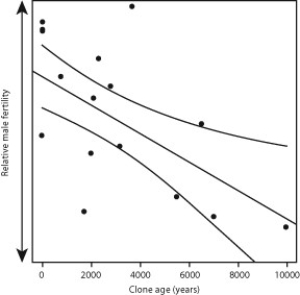Plants differ from many animals because they undergo indeterminate (continual) growth. Indeterminate growth is common in clonal plants because a single clone can continually produce new clones without undergoing sexual reproduction, even if the plant is capable of doing so.
Senescence, an inability to undergo cell division as an organism ages, also occurs in many plants and animals. However, scientists have had a difficult time establishing the occurrence of senescence in cloning plants because of their indeterminate growth patterns. Mutations in somatic cells are common during asexual growth, and these mutations lead to a decrease in sexual fitness. Scientists hypothesize that over time, as these mutations accumulate, they may contribute to senescence in clonal plants. To test this theory, scientists studied a naturally growing population of trembling aspen (Populus tremuloides) , a tree species that grows clones from its root system but is capable of sexual reproduction. To determine if trembling aspens senesce, they compared genetic data of estimated tree age with the variable of "diminishing fertility": the amount of pollen released by male aspen trees. Here are the results for this part of the study:
 Source: Adapted from Ally, D., Ritland, K., & Otto, S. P. (2010) . Aging in a long-lived clonal tree. PLoS Biol, 8(8) : e1000454. doi:10.1371/journal.pbio.1000454.
Source: Adapted from Ally, D., Ritland, K., & Otto, S. P. (2010) . Aging in a long-lived clonal tree. PLoS Biol, 8(8) : e1000454. doi:10.1371/journal.pbio.1000454.
-With each successive generation of clones, the number of genetic mutations in the aspens' DNA increases, causing disruptions in pollen production. If mutation frequency were graphed per age of clones, what would the graph look like? Assume for each of these graphs that age increases moving from left to right on the x-axis and the total number of accumulated mutations increases from bottom to top on the y-axis.
Definitions:
Visual Angle Theory
The concept that the perception of an object's size is determined by its visual angle and the distance from the observer.
Retinal Image Theory
The hypothesis that the retina captures visual images like a camera, which are then processed by the brain.
Perceptual Constancy
A feature of perception in which physical objects are perceived as unvarying and consistent despite changes in their appearance or in the physical environment.
Linear Perspective
A monocular cue for depth perception, where parallel lines appear to converge in the distance, helping the brain perceive spatial relationships.
Q4: About one-third of all animal and plant
Q6: Fatty acids with double bonds between some
Q6: As a physician caring for a nursing
Q11: What part in the figure below will
Q17: The tertiary structure of a polypeptide refers
Q31: A florist assembles a bouquet of flowers
Q43: In a flowering plant, the cells that
Q53: The dominant herbivores in savannas are<br>A) gophers.<br>B)
Q66: Which option best describes the mechanism that
Q80: Which of the following characteristics of a